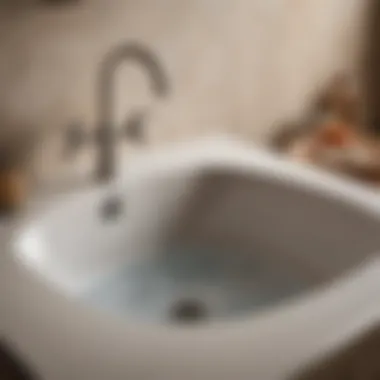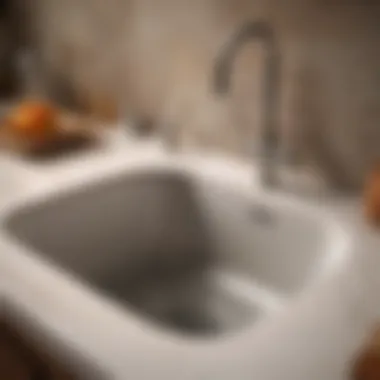Mastering Clogged Sinks: A Comprehensive Guide


Intro
A clogged sink can be a significant annoyance in any household. Understanding how to address this issue not only helps in maintaining a functional kitchen or bathroom but also enhances the overall quality of daily living. This guide aims to provide essential insights on diagnosing, managing, and preventing sink clogs effectively.
With a focus on practical steps, readers will explore various DIY solutions, chemical options, mechanical strategies, and when it becomes necessary to call in professionals. By mastering these techniques, one can ensure smoother plumbing experiences and avoid frustrating disruptions in routine.
Causes of Clogs
Sink clogs can arise from numerous factors. Recognizing these causes is essential for effective diagnosis and prevention. Some common reasons include:
- Accumulation of food particles: In kitchen sinks, leftover food can easily build up in pipes.
- Hair and soap residue: Bathrooms frequently suffer from hair clogs mixed with soap and oils.
- Grease buildup: Pouring grease down the sink leads to solidifying clogs over time.
- Foreign objects: Small items accidentally dropped down the drain can cause immediate blockages.
"An ounce of prevention is worth a pound of cure.” Taking steps to avoid clogs is just as vital as knowing how to clear them.
Diagnosing the Problem
Before attempting any solutions, it is important to accurately diagnose the clog. Here are steps for effective diagnosis:
- Identify the symptoms: Observe if water drains slowly or not at all.
- Check multiple sinks: If more than one sink is clogged, it may indicate a larger plumbing issue.
- Use a plunger: A simple plunge can sometimes reveal the unsuspected nature of the clog.
- Look under the sink: Inspect pipes for leaks or visible blockages.
DIY Solutions
If the issue is minor, several DIY solutions may help:
- Boiling water: Pouring boiling water down the drain can dissolve simple grease clogs.
- Baking soda and vinegar: These combine to create a natural cleaner that can clear less severe blockages.
- Manual removal: If the clog is visible, using a pair of pliers or a snake tool can be effective.
- Wet/dry vacuums: These can be invaluable for sucking up clogs if accessible.
Mechanic and Chemical Strategies
For stubborn clogs, more robust strategies might be needed. Consider these options:
- Drain snakes: These tools are designed for deeper clogs, reaching areas a regular plunger cannot.
- Chemical drain cleaners: Products like Drano or Liquid-Plumr can dissolve tough clogs, but one must be careful due to potential pipe damage.
Safety Measures
When dealing with clogs, safety should never be overlooked. Here are important tips:
- Always wear gloves when handling chemical products.
- Work in well-ventilated areas to avoid inhaling fumes.
- If using tools, ensure they are appropriate for the job to prevent injury.
When to Seek Professional Help
While many issues can be resolved independently, certain situations warrant professional intervention:
- If the clog persists despite all efforts.
- There are multiple plumbing issues across the house.
- Noticing foul odors or unexplained leaks.
These signs can indicate serious plumbing problems needing expert evaluation.
Culmination
Understanding how to deal with clogged sinks is crucial for effective household management. With practical knowledge and proper tools, one can maintain seamless plumbing. Utilizing preventative measures further strengthens one’s ability to manage these common issues, ensuring a well-functioning home environment.
Understanding Sink Clogs
Sink clogs represent a common yet significant issue in household plumbing. Understanding sink clogs is crucial as it enables homeowners to identify problems early and take appropriate action before situations escalate. Not only does it facilitate efficient maintenance, but delving into the complexities of sink clogs equips individuals with the knowledge to minimize risks associated with plumbing emergencies.
Awareness of sink clogging can prevent costly repairs and inconveniences in daily life. Furthermore, comprehending the underlying causes can inform better practices, supporting proactive efforts in maintaining clean and functional plumbing systems.
Common Causes of Sink Clogs
A variety of factors contribute to sink clogs, which may lead to inconvenient and potentially damaging situations.
Accumulation of Food Particles
The accumulation of food particles is one of the most prevalent causes of sink clogs. When bits of food are washed down the drain, they can stick to the interior of pipes over time. Eventually, this buildup leads to blockages that impede water flow.
It is essential to recognize that food particles, especially greasy substances, can cling to pipe walls, making them notorious for forming troublesome clogs. This issue is particularly relevant in kitchen sinks. Regular cleaning and proper disposal methods can be beneficial in addressing this problem. The challenge with food particle accumulation is the potential for it to develop unnoticed, manifesting into significant plumbing issues if not properly managed.
Hygiene Products and Soap Residue


The use of hygiene products, such as sanitary items and wipes, serves as another common contributor to sink clogs. Additionally, soap residue can accumulate in drains, creating a soap scum that traps other debris.
There is a tendency for people to dispose of items in ways that may not suit plumbing systems, leading to challenges. Particularly with modern hygiene products, their design can make them durable, causing them to resist dissolution, which is unfortunate for plumbing. This aspect makes it imperative to develop awareness about what can and cannot be flushed or washed down sinks.
Foreign Objects and Debris
Foreign objects and debris can unexpectedly result in clogs. Items such as hair, small toys, or other unexpected materials can find their way into sink drains, effectively obstructing water flow.
This issue highlights the importance of being vigilant about what enters the sink. Unlike food particles and soap residue, foreign objects are often more easily detectible and removable, but they can still cause considerable issues. Developing a habit of careful disposal and ensuring a clean workspace around sinks can go a long way in preventing such incidents.
Recognizing Symptoms
Understanding the symptoms associated with sink clogs is vital for effective intervention. Identifying these signs early can save time and reduce further complications.
Slow Drainage
Slow drainage is often the first observable sign of a clogged sink. When water takes longer than usual to go down the drain, it can indicate that something is obstructing the flow.
This symptom is often a precursor to more severe problems if left unattended. Recognizing slow drainage early allows for intervention before the situation worsens. By regularly monitoring drainage performance, homeowners can maintain better control over potential plumbing issues.
Unpleasant Odors
Unpleasant odors are another common indication of sink clogs. These smells often result from decomposing organic matter trapped in the drain. When food particles or other biodegradable materials are caught, the resultant decay can lead to foul odors.
It's essential to address this smell promptly, as it may signify a more significant problem in the plumbing system. Not only is it unpleasant, but it can also affect the overall sanitation of the household.
Water Backflow Issues
Water backflow issues present a concerning sign of potential clogs. When water begins to flow backward or does not exit the sink properly, it suggests a blockage somewhere in the plumbing system.
This problem may indicate severe clogging, possibly in the main drain line, and should prompt immediate attention. Prompt action at this stage is critical in preventing further plumbing complications or water damage.
Initial Assessment and Preparation
Understanding the initial assessment and preparation phase is crucial when addressing clogged sinks. This stage sets the groundwork for effective problem-solving. Identifying the tools necessary and ensuring safety measures are in place can make a significant difference. It minimizes risks and maximizes the likelihood of a successful unclogging attempt. Individuals should take the time to evaluate the situation before diving into any solutions.
Tools and Materials Needed
Plumber's Snake
The plumber's snake is an essential tool for tackling deeper clogs. This tool is designed to reach blockages that a plunger cannot access. Its long, flexible structure allows it to navigate through pipes and break apart stubborn clogs.
A key characteristic of the plumber's snake is its reach. It can extend into drains far enough to clear significant obstructions. This makes it a popular choice for homeowners facing serious clog issues. However, users must handle it with care; improper use can risk damaging the plumbing.
Plunger
A plunger is often the first tool many individuals reach for when encountering sink clogs. It operates using air pressure to dislodge obstructions. The unique feature of a plunger is its simplicity and effectiveness for minor clogs.
The primary benefit of using a plunger is its affordability and ease of use. Most households already contain one, making it readily accessible. However, it may not suffice for deeper or more complex issues. Users should recognize its limitations when dealing with serious plumbing problems.
Screwdriver Set
A screwdriver set is fundamental for accessing drain traps and assembling other tools. It helps remove the barriers that may conceal clogs. The uniqueness of a screwdriver set lies in its versatility; it can assist with various home repairs beyond plumbing.
Using a screwdriver set, homeowners can disassemble parts of the sink for better access. This tool provides an effective means to thoroughly inspect and resolve clogs. Yet, novices should proceed carefully to avoid damaging components.
Safety Precautions
Wearing Protective Gear
Wearing protective gear is a vital safety consideration when working on clogged sinks. Such gear may include gloves and goggles. The key characteristic of protective gear is that it safeguards against chemicals and sharp objects that may be present.
This precaution is particularly beneficial in preventing injuries or skin reactions. It's essential for anyone dealing with potentially hazardous materials during unclogging. However, the downside may be the extra time needed for preparation.
Proper Ventilation
Proper ventilation plays a critical role while attempting to clear sink clogs. This is especially important when using chemical cleaners. The primary advantage of maintaining airflow is to reduce the risk of inhaling harmful fumes.
This measure not only protects health but also ensures a more pleasant working environment. However, achieving good ventilation might require opening windows or using fans, which can be inconvenient.


Handling Chemicals with Care
Handling chemicals with care is imperative when dealing with clogged sinks. Different cleaners have various active ingredients that can be harmful if mishandled. The key characteristic of handling chemicals safely is understanding the instructions on the product label.
This safety practice is beneficial in preventing accidents or adverse reactions. Users should carefully follow guidelines for dosage and application methods. Ignoring these can lead to ineffective use or dangerous outcomes.
DIY Solutions for Clogged Sinks
Addressing clogged sinks often involves identifying the clogs and applying effective techniques. This section emphasizes the significance of DIY solutions. These approaches provide homeowners with a sense of empowerment and an immediate option to tackle plumbing issues without waiting for professional help.
Using a Plunger
Choosing the Right Plunger
Choosing the right plunger is critical for effectively unclogging a sink. There are two main types: cup plungers and flange plungers. The cup plunger, with its simple bowl-shaped end, works well for sinks. However, a flange plunger is designed specifically for toilets. While both have their uses, using the correct size and style ensures better performance in removing clogs.
Another key characteristic of a good plunger is its material. Rubber plungers that have a sturdy handle ensure durability and effectiveness. It is important to test the plunger on minor clogs to familiarize yourself with its efficiency.
Proper Techniques for Effective Use
Proper techniques play a crucial role in maximizing plunger effectiveness. First, ensure that there is enough water in the sink to cover the plunger’s cup. This aids in creating a necessary seal. Position the plunger over the drain hole and press down forcefully, creating suction. Then, pull up sharply, and repeat this several times until the blockage gives way.
One unique feature of this technique is its reliance on physical force rather than chemicals, providing a safe and immediate option. However, over-reliance on plunging can lead to frustration if the clog persists. Some may need further assistance for deeper blockages.
Employing a Plumber's Snake
Understanding Different Types of Snakes
Understanding the types of plumber's snakes available is vital for effective use. There are manual snakes and powered snakes. Manual snakes are ideal for minor clogs and are easier to handle. Powered snakes, on the other hand, are suitable for tougher blockages. Their rotating movement allows better access to clogs deeper in the plumbing system.
A unique feature of these tools is their varied lengths, which allow users to reach various depths. While the use of a manual snake requires some labor, it is usually sufficient for most DIY tasks. A powered snake might be more efficient, yet it could require additional precautions due to operating machinery.
Step-by-Step Operation Guide
Using a plumber's snake involves a straightforward process. First, insert the snake into the clogged drain until you feel resistance. Turn the handle to break apart the obstruction. Slowly pull back, ensuring that any loosened debris comes out with the snake. After this, flush the drain with water to remove any remaining residue.
This step-by-step guide simplifies the operation, making it accessible for those unfamiliar with plumbing tools. However, care should be taken to avoid damaging the pipes, which is a notable disadvantage of using a mechanical tool without proper guidance.
Applying Chemical Drain Cleaners
Types of Drain Cleaners
There are several types of chemical drain cleaners available on the market. They include acidic cleaners, alkaline cleaners, and enzymatic cleaners. Acidic cleaners are effective for dissolving tough clogs caused by grease or hair. Alkaline cleaners work on organic matter effectively, while enzymatic cleaners are more environmentally friendly, using bacteria to break down waste.
The uniqueness of these various types allows homeowners to choose based on the specific cause of their clog. Not all cleaners are safe for every plumbing system, and their misuse can cause damage, making it essential to understand each type's specific use cases.
Effectiveness and Limitations
When considering chemical drain cleaners, their effectiveness can vary. While many products promise quick results, they require time to work. Additionally, they might not always clear stubborn clogs, especially those deep in the system.
Another factor to consider is the potential for pipe damage. Many chemical cleaners can be corrosive over time, leading to leaks or further issues. Thus, their usage should be balanced with safety precautions and alternative methods, ensuring the clean and reliable functionality of your plumbing.
Preventive Measures for Future Clogs
Preventive measures are essential in reducing the likelihood of sink clogs. Regular attention to these measures leads to a smoother plumbing experience. Sinks often collect debris over time. By taking proactive steps, you can save yourself time and money spent on future repairs or emergency calls. A comprehensive plan for prevention is worth considering.
Regular Maintenance Practices
Routine Cleaning Tips
Routine cleaning of your sink can greatly reduce the chance of clogs. This practice involves simple tasks, such as periodically rinsing your sink with hot water. Using a mixture of baking soda and vinegar is another effective method. Both ingredients work together to break down build-up in pipes. The key characteristic of this method is its simplicity and lack of harsh chemicals. It not only removes debris but also keeps the plumbing fresh.
Advantages of routine cleaning include improved water flow and reduced unpleasant odors. Many households find it to be a popular practice for its effectiveness and ease of implementation. However, while routine cleaning is beneficial, it does not eliminate the need for professional services occasionally.
Using Sink Strainers
Using sink strainers is another effective measure to prevent clogs. A strainer acts as a physical barrier that catches food particles and other debris. This device is simple to use and an important feature of kitchen sinks. Fitting a strainer in the drain can significantly minimize the chances of food remnants entering the pipes. This proactive action is beneficial for homes where cooking is frequent.
The main advantage of using strainers is that they are cost-effective and easy to clean. Regularly removing and washing the strainers ensures maximum effectiveness. However, one potential drawback is that they require consistent upkeep. If neglected, strainers can become clogged themselves, leading to additional problems.


Educating Household Members
Educating those in your household about proper sink usage is also vital. Clear communication is essential in preventing future clogs. By informing everyone of the correct disposal practices, you can create a shared understanding of responsibilities. This shared knowledge can help maintain a clean sink environment.
Proper Waste Disposal Habits
Teaching proper waste disposal habits is key. Remind household members to avoid disposing of items like leftover food or grease down the sink. Instead, encourage composting or using the trash for such waste. This education can foster good behaviors over time. The main advantage is that it helps prevent accumulation before it becomes a problem. The downside is that this information may need frequent reinforcement to maintain awareness.
Awareness of Prohibited Items
Creating an awareness of prohibited items is equally as important. Many households are unaware of what can damage plumbing systems. Items like coffee grounds, dental floss, and hygiene products can cause significant blockages. Make a list of items that should never enter the sink. This additional knowledge can prove beneficial in maintaining a functional drainage system.
The unique feature of this awareness program is its ability to promote proactive habits. Families tend to appreciate clear guidelines that reduce frustrations. However, ensuring everyone is aware requires consistent communication and reminders.
By implementing preventive measures, not only do you maintain the efficiency of your plumbing, but you also create a healthier environment for your household.
In summary, taking preventive measures against sink clogs necessitates routine cleaning, the use of strainers, and ongoing education. Actions taken today can prevent issues tomorrow.
When to Call a Professional
Addressing clogged sinks can often be managed with DIY solutions. However, there are specific situations when calling a professional becomes essential. Recognizing when to seek expert help is crucial to prevent further damage and ensure swift resolution. Ignoring ongoing issues can lead to bigger problems, including extensive plumbing repairs or even water damage to the home.
Signs That Indicate Professional Help is Needed
Persistent Clogs
Persistent clogs can be a significant indication that homeowner's solutions are not sufficient. If a sink continues to clog despite repeated attempts at clearing it, professional intervention is warranted. A key characteristic of persistent clogs is their ability to resist common remedies such as plunging or using a plumber's snake. This resistance signals more serious underlying issues in pipelines, such as buildup in the pipes or tree roots invading the sewer line.
Using professionals enables a thorough inspection of the plumbing system. The unique feature of dealing with persistent clogs is that a trained plumber can use specialized equipment to identify blockages deeper in the system. Not attending to persistent clogs can lead to more severe and expensive repairs if left unattended.
Water Damage Concerns
Water damage concerns elevate the situation, necessitating prompt action. This issue often arises when leaks from a clogged sink result in moisture accumulations in walls or under floors. A key characteristic of water damage is mold growth, which can pose health risks to the household. Addressing this can become a crucial matter in the maintenance of both the property and well-being.
When water damage follows or accompanies a clog, the unique aspect of professional services is their capability to both fix the immediate clog and evaluate any resultant damage. The advantage of professionals in these cases is their access to tools and moisture detection equipment that ensure thorough assessment and resolution of the problem.
Increased Plumbing Noise
Increased plumbing noise can serve as an audible cue that indicates troubles within the system. This often manifests as gurgling noises or loud water flow sounds. A key characteristic of increased plumbing noise is its potential to signify air trapped in pipes or blockages that require attention. If this noise becomes increasingly noticeable, it may warrant expert evaluation.
Professionals are equipped to identify the root cause of such noises, which may arise from deeper plumbing issues. Their unique feature is their ability to analyze the plumbing layout thoroughly. By choosing professional help in these situations, homeowners can prevent further issues, ensuring their plumbing system works efficiently.
Choosing the Right Plumbing Service
Selecting a qualified plumbing service is paramount once the decision to call a professional has been made. Not all services offer the same level of expertise or quality. Thus, careful consideration is required to make an informed choice.
Assessing Credentials and Experience
When assessing credentials and experience, it is vital to confirm that the plumbing service holds relevant licenses and certifications. A trustworthy service ensures that its team is skilled and knowledgeable about current plumbing technology and regulations. A key characteristic is the service’s track record; reviews and referrals can provide insight into their reliability and effectiveness.
With in-depth experience, a professional service can tackle a variety of plumbing situations, ensuring effective solutions. A major advantage of working with experienced plumbers is their speed and efficiency in problem identification, which could save time and resources in the long run.
Understanding Service Costs
Understanding service costs is another crucial element in selecting the right plumber. Homeowners should request detailed quotes before engaging a service to avoid any surprises. A key characteristic of cost understanding includes transparency and clarity in the services offered. Knowing potential costs upfront can assist in comparing different plumbing services.
The unique feature of being informed about pricing structures is that it allows homeowners to make budget-friendly decisions. This also enables them to weigh the value of potential services against their financial constraints. Balancing service quality with costs is crucial for effective resolution of plumbing issues.
Finale
In the realm of home maintenance, understanding how to address clogged sinks offers significant advantages. Clogs are not just inconvenient; they can lead to more severe plumbing issues if ignored. This article highlights essential insights and preventative measures, allowing individuals to manage sink problems effectively.
The importance of this topic cannot be overstated. First, it empowers homeowners with knowledge. With a solid understanding of the causes and resolutions for sink clogs, anyone can take proactive steps to maintain their plumbing. Moreover, acknowledging when it's necessary to seek professional help can save time and money in the long run.
Recap of Key Insights
- Common Causes: Recognizing the various factors that lead to clogged sinks is vital. Whether it is food particles, hygiene products, or foreign debris, awareness is the first step towards prevention.
- DIY Solutions: Embracing practical solutions, such as using a plunger or a plumber's snake, provides immediate relief without the need for costly services.
- Prevention: Regular maintenance and education on proper waste disposal are highly effective for preventing future clogs.
- Professional Help: Knowing when to call an expert is necessary to avoid further complications, especially when persistent clogs or damage occurs.
Emphasizing the Importance of Prevention
Preventing sink clogs is crucial for several reasons. First, it promotes a smoother household operation. Regular maintenance practices, such as cleaning and the use of sink strainers, keep your sink in optimal condition. Additionally, educating all household members on proper disposal habits takes communal responsibility seriously.
Second, prevention saves money. By minimizing the risk of clogs, you reduce the chances of requiring extensive plumbing repairs. A little education pays off big by curtailing plumbing mishaps.
In summary, addressing clogged sinks today enhances tomorrow's peace of mind. Prioritizing this knowledge leads to more informed and confident homeowners. Proactive strategies not only protect plumbing systems but also improve overall home hygiene.















